Preventing WIPlash: Implementation of a Controlled Release Strategy to Improve Shop Performance
Author(s)
Covell, David D.
DownloadThesis PDF (1.132Mb)
Advisor
Whitney, Daniel
Carrier, John
Boning, Duane
Terms of use
Metadata
Show full item recordAbstract
Complex manufacturing systems are managed through their schedules, which help to make sure that the right part is in the right place at the right time. The challenge that many companies face is that the schedule is based off of a series of assumptions, and the manufacturing system suffers when inevitable variability interferes with the best laid plans. The challenge addressed in this paper involves how to consume an operation schedule and maximize output in a system with significant sources of variability.
What follows is a case study on the use of well-documented methods in operations management to improve the performance of a manufacturing system. Through the use of Lean process mapping, Theory of Constraints focus on the bottleneck, and
CONWIP methods of order release, I show that it is possible to achieve lower Work-In-Progress (WIP) levels and improved performance on key metrics relative to a purely push system. Successful implementation of the release strategy required not only an understanding of factory dynamics, but also an understanding of the dynamics surrounding implementation of changes within a balanced organization.
Date issued
2023-06Department
Massachusetts Institute of Technology. Department of Electrical Engineering and Computer Science; Sloan School of ManagementPublisher
Massachusetts Institute of Technology